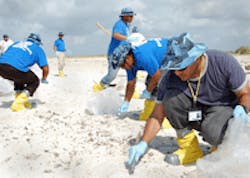Task Force Releases Final Strategy for Reversing Deterioration of Gulf Ecosystem
The task force delivered the final strategy on Dec. 2 to President Barack Obama, who established the task force by executive order to continue the administration’s ongoing commitment to the Gulf region. The group is made up of representatives from the five Gulf states and 11 federal agencies, including the Environmental Protection Agency, the White House Council on Environmental Quality, the Department of Agriculture, the Department of Commerce, the Department of Defense, the Department of the Interior, the Department of Justice, the Department of Transportation, the Office of Management and Budget, the Office of Science and Technology Policy and the White House Domestic Policy Council.
The task force sought input from local leaders and those impacted by the crisis in the Gulf, causing Lake Charles, La., Mayor Randy Roach to comment, “When you read the report, it is obvious that they listened to what they heard and addressed our concerns in a very straightforward manner. This report is an important document that outlines the challenges of recovery and the opportunities we have to develop a true intergovernmental approach to address the needs and interests of the people of the Gulf Coast region.”
The strategy is the first restoration blueprint ever developed for the Gulf and represents a commitment by all parties to continue to work together in an unprecedented collaboration to prepare the Gulf region to transition from response to recovery and address the decades-long decline that the Gulf’s ecosystem has endured.
“After the Deepwater Horizon disaster, this task force brought together people from across the Gulf Coast in unparalleled ways to talk about how we tackle both the immediate environmental devastation, as well as the long-term deterioration that has for decades threatened the health, the environment and the economy of the people who call this place home. It has all come to this moment – when we move from planning and researching to supporting real, homegrown actions aimed at restoring this vital ecosystem,” said EPA Administrator and Task Force Chair Lisa P. Jackson.
Strategy Moves from Planning to Action
With the release of the final strategy, the Task Force moves from planning to action, starting the implementation phase of the strategy by announcing new initiatives, including $50 million in assistance from the U.S. Department of Agriculture’s Natural Resources Conservation Service to help agricultural producers in seven Gulf Coast river basins improve water quality, increase water conservation and enhance wildlife habitat.
“To ensure the future health of the Gulf, its economy and its residents, the nation must start the work of creating a sustainably healthy and productive landscape and seascape – not only stopping the ongoing degradation but beginning the process of reversing that which has already occurred,” said Senators Bob Graham and William K. Reilly, co-chairs of the National Commission on the BP Deepwater Horizon Oil Spill and Offshore Drilling. “Working with the people of the Gulf, the Gulf Coast Ecosystem Restoration Task Force has undertaken the challenge of developing an ecosystem restoration strategy to guide the long-term collaboration necessary to reverse the trend of environmental degradation in the Gulf. The country needs to make the commitments called for and it needs to make them now.”
USDA's multi-year environmental restoration effort, known as the Gulf of Mexico Initiative, or GoMI, represents a 1,100 percent increase in financial assistance for Gulf priority watersheds.
“Restoring the Gulf Coast ecosystem needs to begin immediately and USDA’s assistance is an important first step in placing the Task Force strategy into action”, said USDA Under Secretary Harris Sherman. “This collaborative voluntary effort will leverage contributions and commitments from farmers, communities and all levels of government to improve water quality. A healthy water supply is not only vital for the people of the Gulf, but also for the estuaries, fisheries and wildlife that are the foundation of the local economy.”
The task force also has begun reviewing existing policy, program and regulatory issues that are slowing down restoration progress, particularly in the habitat restoration area. The Task Force will continue to explore innovative ways to implement restoration, measure success and support the restoration with science.
Priorities
The natural resources of the Gulf’s ecosystem are vital to many of the region’s industries that directly support economic progress and job creation, including tourism and recreation, seafood production and sales, energy production and navigation and commerce. Among the key priorities of the strategy are:
1) Stopping the loss of critical wetlands, sand barriers and beaches – The strategy recommends placing ecosystem restoration on an equal footing with historic uses such as navigation and flood damage reduction by approaching water resource management decisions in a far more comprehensive manner that will bypass harm to wetlands, barrier islands and beaches. The strategy also recommends implementation of several congressionally authorized projects in the Gulf that are intended to reverse the trend of wetlands loss.
2) Reducing the flow of excess nutrients into the Gulf – The strategy calls for working in the Gulf and upstream in the Mississippi watershed to reduce the flow of excess nutrients into the Gulf by supporting state nutrient reduction frameworks, new nutrient reduction approaches, and targeted watershed work to reduce agricultural and urban sources of excess nutrients.
3) Enhancing resiliency among coastal communities – The strategy calls for enhancing the quality of life of Gulf residents by working in partnership with the Gulf with coastal communities. The strategy specifically recommends working with each of the States to build the integrated capacity needed through effective coastal improvement plans to better secure the future of their coastal communities and to implement existing efforts underway.
About the Author

Sandy Smith
Sandy Smith is the former content director of EHS Today, and is currently the EHSQ content & community lead at Intelex Technologies Inc. She has written about occupational safety and health and environmental issues since 1990.
